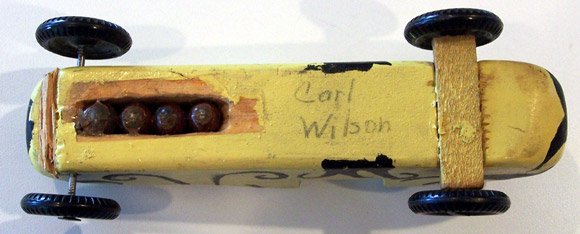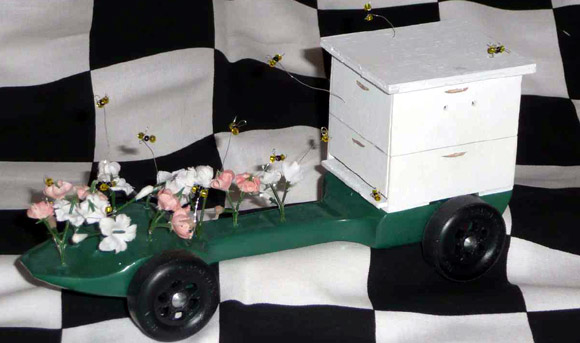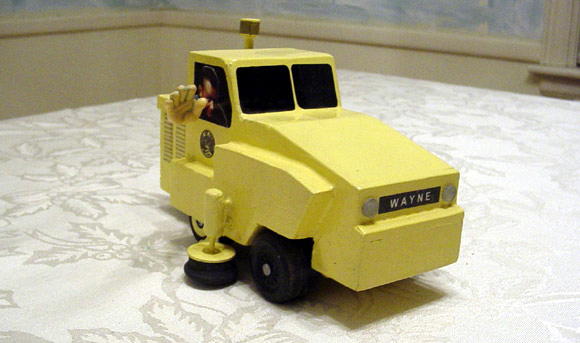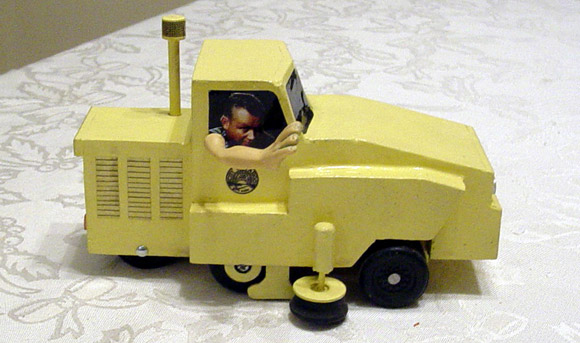– Feature Article – Raising the Performance Bar
– Pinewood Derby Car Showcase
– Memory – A Crashing Halt and a Great Finish!
– Q&A
Raising the Performance Bar
(This is an updated version of an article that first appeared in Volume 2, Issue 7 – December 24, 2002)
Most people have a sense of fair play. When two mismatched teams or individuals compete with each other, interest usually wanes, and from a sense of sympathy oftentimes the underdog is the crowd favorite. But when inferior equipment, questionable coaching, or unawareness of the rules disadvantages one competitor, most people hardly consider the event to be a truly fair contest.
People generally prefer to watch an event where the teams or individuals are evenly matched. When skills, equipment, coaching, and officiating are all relatively even, then a sense of fairness prevails and — because the outcome of the event is uncertain — the interest level of the spectators remains high.
Similarly in pinewood derby racing the most exciting events are those in which many of the cars are closely matched in performance. Since the outcome is uncertain, everyone will be on the edge of their seats until the races are concluded.
Due to mistakes, inexperience, shoddy work, etc., there will always be some cars that are out-classed. But the goal of the race organizer should be to give each entrant a full opportunity to perform at a high level.
How is this done? In today’s article I will share several ideas for leveling the playing field, not by penalizing the best cars, but instead by raising the performance bar.
Equal Access To Information
The first way to level the playing field is to provide clear and complete rules for the event. The rules should clearly state what is, and what is not allowed. Rules that require interpretation will result in entries using performance-improving techniques that others had assumed were disallowed. This can only result in disappointment or disillusionment.
Please note that I am not advocating highly restrictive rules. On the contrary, I prefer to allow car designers to use their creativity and ingenuity to increase performance. But to do this, the rules must clearly state what is in bounds, and what is out of bounds.
Another kind of information to distribute is performance tips. Although veterans of your event will likely know the tips already, this information will most certainly be an eye opener to newcomers.
Equal access to performance tips could consist of distributing:
- a list of the better pinewood derby-related web sites,
- a locally-developed tip sheet, a tip sheet from a web site, or
- a commercially available speed tip booklet.
In any case, all participants should receive the race rules and the performance information at the time when the car kits are distributed.
Equal Access To Tools
To raise the performance bar, participants should have equal access to the required tools. In every organization there are some folks with an extensive workshop and with skills to match. Others may not even own a hand saw. Clearly, this leads to lopsided events.
A simple way to provide equal access to tools (and skills) is to hold one or more workshops prior to the event. Of course workshops are more than just an opportunity to share tools. These events provide opportunities for comparing/learning techniques, collaborating on design ideas, and in general becoming more competent in car building. In recent years, we have held a workshop for our group on two consecutive Saturdays at Maximum Velocity. Kids and parents use the tools, seek advice, test cars on the track, and collaborate with the other participants. For those with little pinewood derby experience, attending a workshop can make a big difference in car performance.
In particular I remember two boys and their single mom who attended a workshop for some assistance. I helped them add weight to the car, prepare the wheels and axles, and loaned them some graphite. They ended up taking first and second in their age category — not bad for their first event!
Equal Access To Practice Time
Another way to raise the performance bar is to allow practice time on a derby track. This gives participants the opportunity to test their cars, and thus recognize if changes are needed.
One concern with allowing practice time is that some competitors may become disillusioned if they are continually bested during practice. To avoid this issue, disallow racing between competitors during the practice time. Instead, each entrant may run their car alone (sufficient if the track has a timer), against the entrant’s car from a previous year, or against a “benchmark” car. This minimizes comparing cars during the practice time, but still allows the entrants to ascertain how their car is performing.
Competition Levels
Would you consider it a true competition if the New York Yankees were pitted against a college baseball team? Not likely. But a similar mismatch does occur in some pinewood derby events. If your derby has rather flexible car design rules (e.g., allows modified wheel bases, machined wheels, or similar), then likely the event will end up with some high-performance cars leaving the more traditional cars in the dust.
Obviously, the rules could be tightened to disallow certain modifications, but I suggest an alternative. Instead of reducing design options, consider offering different entry classes. How about a “Stock” class race for cars with standard wheel bases, unmodified wheels, etc., and an “Open” class race for cars with extended wheel bases, modified wheels, etc? This will require more awards, and a little more time. However, I believe you will find the increased competition and excitement will more than compensate for the additional cost.
Conclusion
Raising the performance bar can help to make for a more memorable pinewood derby event. By providing equal access to information, tools, and practice time, and by possibly having multiple event classes, the races will be closer and more exciting.
By the way, what I have included in this article certainly does not exhaust the possibilities for raising the performance bar. If you have other ways to raise the level of competition, please share them with me. Thanks!
Pinewood Derby Car Showcase
The Hive: Scott Morrill
We held a derby as the main event at our family reunion this past summer. My grandfather was a beekeeper, so in his honor I created “The Hive”. The hive itself is an empty shell of balsa which also hides the tungsten weight. The bees were individually created with beads and wire to form the wings and stingers.
Wayne: Bob Kirmis
I am not a scout but rather a mid-forties guy who is part of an annual pinewood derby race at my place of employment. This “car” is a City of Fargo, North Dakota “Wayne” street sweeper. As you can probably guess, I am from Fargo. The guy driving the street sweeper is my dad (who is coincidentally named Wayne).
The two back wheels are glued together to create one wide wheel. The car is elevated about a quarter inch so that it would fit on our track. As you can guess, the car didn’t do real well in the speed category.
Pinewood Derby Memory
A Crashing Halt and a Great Finish!
To start with, at forty-nine, I’m a fairly old Dad to have three sons aged eight, seven, and five. My two oldest sons are Cub Scouts and my youngest son will start scouting in the fall. My middle son won our overall Pinewood Derby championship last year. I compete in the open class of our Pinewood Derby.
I was a Cub Scout way back in the 1960’s and early 1970’s. The Pinewood Derby was a big deal back then too! When I was a Bear Cub, I was entered in our Pinewood Derby. It was Cub Scout Pack 27 in Fort Worth, Texas. I can’t recall what the track was constructed of, but it was the coolest thing that I had ever seen! They had created awards out of coffee can lids, leather, and gold glitter. Those simple awards looked like Olympic Gold Medals to me!
I think my Mom and Dad did more than their “fair share” of work on my car. My Dad could build anything out of metal or wood and he was very competitive. So was my Mom as my car was awarded, “Best Paint Job”. I still have that race car and you can tell by looking at it that no little kid built this by himself.
We had our pre-race ceremonies and the excitement built up even more for me. I was very excited about getting a chance to race my car. My car looked like it would be fast and I was very proud of it. Both my parents kept telling me over and over again to be very careful with my car and to not drop it. As with any kid, I could not put my race car down. I carried it with me everywhere.
Well, we started the race and my Pinewood Derby car was a speed demon! I don’t remember how many boys were in our Pack, but I was beating everyone from the Webelos to the Bobcats. After every heat that my car was in, I snatched it up and pranced around with it. I remember looking at my Dad a couple of times and he was smiling and laughing along with me. Those were very special moments for me as my Dad was “old school” and he didn’t let on too often that he was pleased. I can still hear my Mom and Dad saying, “Be careful with your car and don’t drop it.” Those same words haunt me to this very day.
Our Pinewood Derby was finally winding down and I was still undefeated. I had just finished grabbing my car off the track after another victory when disaster struck! I can still recall that exact moment like it happened yesterday. I still see it in slow motion. I was holding my race car when suddenly, I wasn’t holding it anymore! It seems like it took two minutes for my car to hit the floor. As it smashed down, the two front wheels shot outwards away for my car. The wheels and nails went rolling and spinning away.
I remember the room went quiet and I looked towards my Dad. That in itself was a memorable moment. The expression on his face was a mixture of sadness, anger, and defiance. He came over and gathered the wheels and nails. I was upset and he told me that it would be all right; he could fix it. I was in shock as I thought the car was ruined!
Pinewood Derby cars were way different than they are these days. The axles were mounted into glued-on wooden struts. The front axle strut on my car had actually shattered and was gone! So my Dad laid the car on it’s side and with the palm of his hand, he actually pushed the nail axles right into the side of the wooden car body!

If there is a moral to this story, it’s leave your race car alone and listen to your Mom and Dad. Sometimes, they are actually right about stuff!
Carl “Crash” Wilson
Q&A
Is there truth to reducing friction by only having 3 wheels touch the track surface or is there a negative effect?
The friction isn’t reduced, but there are several advantages to a raised wheel:
- Less inertia to start the car rolling,
- Easier to align,
- Front wheels don’t fight each other if the alignment isn’t perfect,
- A wheel that doesn’t spin as well can be used as the raised wheel,
- Car sits with more stability on three wheels than on four (as long as the added weight is placed towards the rear of the car).
I was able to get my son’s car to roll straight, but it zigzags in the flat section of the track. How do I correct this?
This is a common problem, often attributed to the wheels and axles. But in most cases the problem is that the car is too back weighted for the track.
Lay a ruler on it’s long edge (or use a Balance Stand), then balance the car on the ruler (front to back). Determine the point at which the car balances, then measure the distance from that point to the rear axle.
On most tracks a good distance is 1 inch in front of the rear axle. On a very smooth metal track you can sometimes push this to 3/4 inch in front of the rear axle. But the further back you go, the greater the risk of the “death rattle” that you are experiencing.
To correct the zigzagging, you will need to move some weight forward on the car until the car stabilizes, or implement rail-riding alignment.
Want Answers?
Do you have a pinewood derby-related question? If so, e-mail us your question.We answer all questions by e-mail, but not every question will appear in the Q&A section of the newsletter.
Back Issues
Are you a new subscriber, or have you missed some of the previous newsletters? Don’t miss out; all of the issues for Volume 5 through Volume 17 are posted on our web site.
Newsletter Contributions
We welcome your contributions. If you would like to contribute an article, a web site review, a speed tip, or a pinewood derby memory, please e-mail us.
Subscription Information
The Pinewood Derby Times is a free e-newsletter focused on pinewood derby racing. It is published biweekly from October through March.
If you haven’t already done so, please forward this issue to your pinewood derby friends. But please don’t subscribe your friends. Let them decide for themselves. Thanks.
If this newsletter was forwarded to you, why not subscribe to receive this newsletter. There is no cost, and your e-mail address is safe, as we never sell or share our distribution list.
To subscribe, send a blank e-mail to
[email protected]
You will receive a confirmation e-mail. Reply to the confirmation e-mail and you will start receiving the Pinewood Derby Times with the next issue.
Randy Davis, Editor, Pinewood Derby Times
E-Mail: [email protected]
(C)2018, Maximum Velocity, Inc. All rights reserved. Please do not reprint or place this newsletter on your web site without explicit permission. However, if you like this newsletter we grant permission, and encourage you to e-mail it to a friend.
Maximum Velocity disclaims any personal loss or liability caused by utilization of any information presented in this newsletter.
The Pinewood Derby Times is not specific to, and is not affiliated with the Boy Scouts of America, YMCA, Awana, or any other organization.
(R)Maximum Velocity is a registered trademark of Maximum Velocity, Inc.
(R)Pinewood Derby is a registered trademarks of the Boys Scouts of America.
(R)Awana is a registered trademark of Awana Clubs International.
All other names are trademarks of their respective owners.




